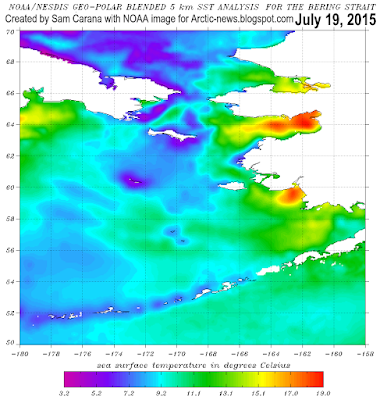Due to warm ocean waters and to heatwaves on land that extended over the Arctic Ocean, while warming up rivers ending into the Arctic Ocean, the sea ice has taken a battering over the past few weeks, as illustrated by the images below.
Above image shows the last bit of thick (5 m) sea ice in the Canadian Archipelago, which became dislodged on July 8, 2015. It looks set to be virtually gone by August 7, 2015, according to the 30-day Naval Research Laboratory animation below, and as also discussed in greater detail in a recent post.
The situation at the north-eastern tip of Greenland doesn't look much better, as illustrated by the image below.
The comparison image below also shows the north-eastern tip of Greenland on July 5, 2015 (top), and on July 31, 2015 (bottom). The bottom image shows water in many places, pushing the last pieces of thick ice into the Wandel Sea and Fram Strait .
 |
| [ click on images to enlarge ] |
Until now, the thicker multi-year sea ice used to survive the melting season, giving the sea ice strength for the next year, by acting as a buffer to absorb heat that would otherwise melt away the thinner ice. Without multi-year sea ice, the Arctic will be in a bad shape in coming years.
 |
| [ click on images to enlarge ] |
So, will the sea ice collapse this year? Consider the following four points:
 Volume - The image on the top right shows sea ice volume as calculated by PIOMAS at the University of Washington. It shows that in June, volume was less than 2015 in only four years, i.e. 2010 through to 2013. The situation has deteriorated much in July 2015, and looks set to deteriorate even further.
Volume - The image on the top right shows sea ice volume as calculated by PIOMAS at the University of Washington. It shows that in June, volume was less than 2015 in only four years, i.e. 2010 through to 2013. The situation has deteriorated much in July 2015, and looks set to deteriorate even further. Thickness - Volume is calculated by looking at both thickness and extent. Thickness is looking much worse than it did in the years 2012 through to 2014, as illustrated by above image.
Thickness - Volume is calculated by looking at both thickness and extent. Thickness is looking much worse than it did in the years 2012 through to 2014, as illustrated by above image.In my experience, sea ice thickness hasn't looked this bad for this time of the year since records began, especially when taking the loss of multi-year ice into account, as also illustrated by the full-width above image.
Extent - Sea ice extent on July 31 was only outside the 2 standard deviations (shaded area) in the years 2007, 2011 and 2012, as illustrated by the image mid right. The dark blue line marks the 2015 extent, with the dot indicating extent on July 31, 2015.
Area - Similarly, Arctic sea ice area is illustrated by the image on the right. For a description of the difference between extent and area, view this NSIDC FAQ page. The bottom right image marks Arctic sea ice area as on July 30, 2015. The yellow marker indicates the situation for the year 2015 on this date. The only years with less sea ice area at this time of the year were 2007, 2011 and 2012.
Also consider that 2015 features very high sea surface temperatures and an El Niño that is still gaining in strength. Thick sea ice appears to be shattered, as illustrated by the satellite images. In conclusion, sea ice looks set to take a further battering over the next few weeks and could end
up at a record low thickness, extent, area and volume around half September 2015.
With that in mind, let's take a look at the image below.
Above image shows a trendline (shaded area) based on satellite data from 1979-2014, with annual minimum volume figures calculated by PIOMAS. The shaded area points at a total disappearance of the sea ice as early as September 2018. The width of the shaded area reflects natural variability, but natural variability could be wider than that, as illustrated by the fact that minimum volume in the years 2007, 2010, 2011 and 2012 was lower than the shaded area. In other words, disappearance of the sea ice could occur even earlier than September 2018 and if things get really bad, collapse could even occur as early as September this year.
The situation is dire and calls for comprehensive and effective action, as discussed at the Climate Plan.
Will the sea ice collapse this year? Firstly, consider that sea ice volume now hasn't been this bad for any day in July...
Posted by Sam Carana on Friday, July 31, 2015


















































